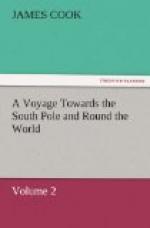At half past seven, we passed this famous cape, and entered the southern Atlantic ocean. It is the very same point of land I took for the cape, when I passed it in 1769, which at that time I was doubtful of. It is the most southern extremity on a group of islands of unequal extent, lying before Nassau Bay, known by the name of Hermite Islands, and is situated in the latitude of 55 deg. 58’, and in the longitude of 68 deg. 13’ W.; according to the observations made of it in 1769. But the observations which we had in Christmas Sound, and reduced to the cape by the watch, and others which we had afterwards, and reduced back to it by the same means, place it in 67 deg. 19’. It is most probable that a mean between the two, viz. 67 deg. 46’, will be nearest the truth. On the N.W. side of the cape are two peaked rocks, like sugar-loaves: They lie N.W. by N., and S.E. by S., by compass, of each other. Some other straggling low rocks lie west of the cape, and one south of it; but they are all near the shore. From Christmas Sound to Cape Horn the course is E.S.E 1/4 E., distant thirty-one leagues. In the direction of E.N.E., three leagues from Cape Horn, is a rocky point, which I called Mistaken Cape, and is the southern point of the easternmost of Hermite Isles. Between these two capes there seemed to be a passage directly into Nassau Bay; some small isles were seen in the passage; and the coast, on the west side, had the appearance of forming good bays or harbours. In some charts, Cape Horn is laid down as belonging to a small island. This was neither confirmed, nor can it be contradicted by us; for several breakers appeared on the coast, both to the east and west of it; and the hazy weather rendered every object indistinct. The summits of some of the hills were rocky, but the sides and vallies seemed covered with a green turf, and wooded in tufts.
From Cape Horn we steered E. by N. 1/2 N., which direction carried us without the rocks that lie off Mistaken Cape. These rocks are white with the dung of fowls, and vast numbers were seen about them. After passing them we steered N.E. 1/2 E. and N.E., for Strait Le Maire, with a view of looking into Success Bay, to see if there were any traces of the Adventure having been there. At eight o’clock in the evening, drawing near the strait, we shortened sail, and hauled the wind. At this time the Sugar-loaf on Terra del Fuego bore N. 33 deg. W.; the point of Success Bay, just open of the cape of the same name, bearing N. 20 deg. E.; and Staten Land, extending from N. 53 deg. E. to 67 deg. E. Soon after the wind died away, and we had light airs and calms by turns till near noon the next day, during which time we were driven by the current over to Staten Land.




